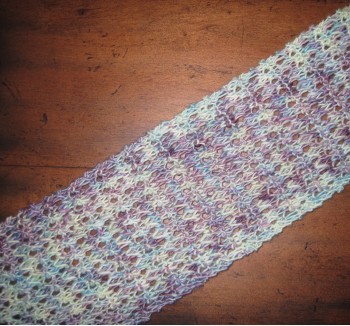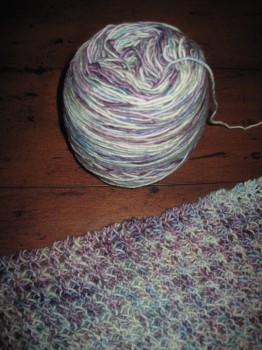I received one hank of Madelinetosh Tosh Merino Light in a Mother’s Day yarn bouquet last year. This specially-dyed yarn contained a lovely mix of shades ranging from off-white, to pale mint, to light blue, to lavender, with small specks of darker blue and deeper purple here and there. While there are many colors within the yarn, they complement each other and have a subtle appearance overall.
Since I only had one hank, I decided to make a scarf. I wanted a pattern that was simple, so it didn’t compete with the yarn’s many hues, but had some visual interest, so it wasn’t boring. And since both sides of a scarf are often visible when it’s being worn, I wanted a reversible scarf pattern.
The pattern I created is simple but has texture, and beautifully highlights the yarn’s changing hues. It is also completely reversible, thus ensuring your scarf will look fantastic no matter how you wear it. I called this scarf “Hydrangea” because the yarn’s colors—white, blues, and purples—reminded me of the colors of hydrangeas I most often see around my neighborhood and at the flower shop.
The colorway I used was exclusive to that Mother’s Day yarn bouquet, so unless you also received the lovely bouquet (and still haven’t used your hank!), you will not be able to use this colorway. However, Madelinetosh Tosh Merino Light comes in a plenitude of beautiful colors, and I am sure you could find a substitute colorway that will make an equally gorgeous scarf. You also could use any fingering weight yarn as a replacement.1 I just love the hand-dyed colors by Madelinetosh, but the interesting stitch pattern I chose for this scarf would be eye-catching with a solid yarn as well.
This scarf uses a twist brioche pattern, which creates a meshed and very stretchy fabric. The written instructions for the twist brioche pattern may seem complicated, but the pattern really is not. Check back in a few days and you can see for yourself by watching my demonstration video.2

My Hydrangea Scarf, after blocking. The meshed fabric opened up and the pattern is much more visible. The scarf is also thinner and longer now.
Whether you choose to block your scarf is a matter of preference. Following this pattern produces a lovely scarf without any blocking. If you don’t block your scarf, it will remain about 5” wide, and you can just continue to knit until it is the length you desire. If you want to really see the pattern and prefer a thinner scarf, you can block your scarf. I chose to block mine so it would be 4” wide, which increased its length by about 45% (my finished, pre-blocked scarf was 55” long; after blocking it was 80” long). If you choose to do as I did, keep in mind how much blocking will add to the length of your scarf and stop knitting accordingly.
To make your own version of my Hydrangea Scarf, download the pattern here:
- You really could use any weight of yarn with this pattern. However, if you don’t use a fingering weight, you should make a gauge swatch so you can choose how wide you want your scarf to be and cast on the appropriate number of stitches. To keep the twist brioche pattern, you’ll need to cast on a multiple of 3 stitches plus 2. [↩]
- I had intended to insert the video into this post, but I need help making the video and it just didn’t happen this week. Making the video is on my “list” for this weekend though, so check back next week. [↩]

